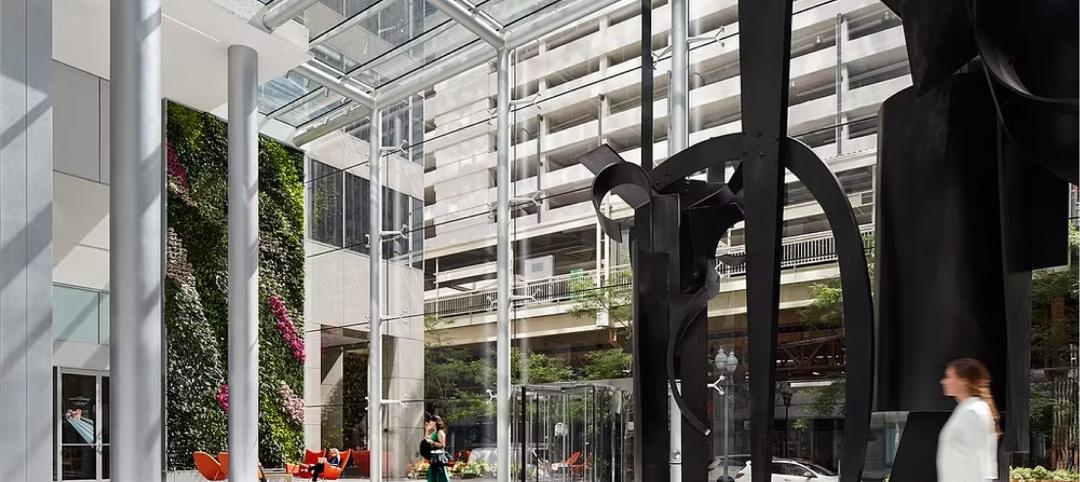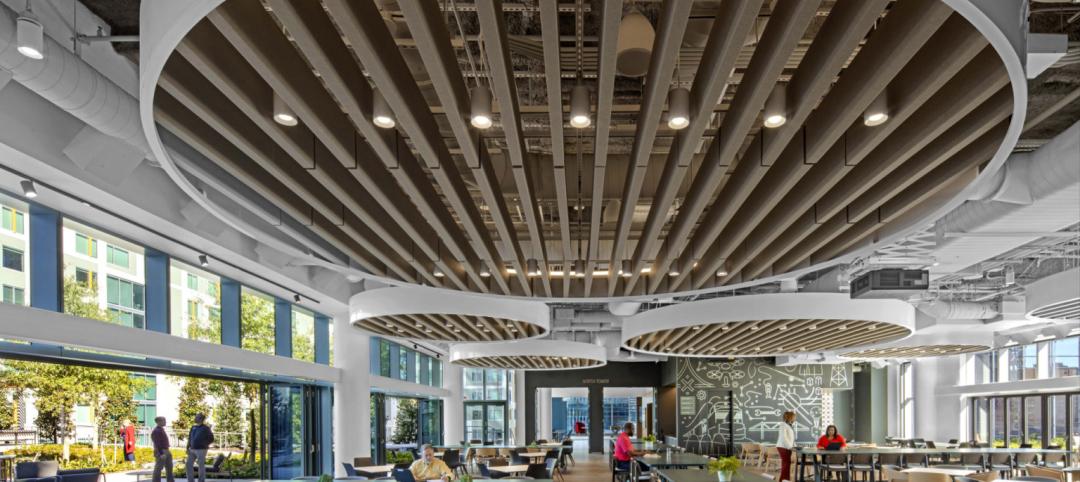What can companies be doing better to ensure that their workplaces provide the healthiest and most efficient environments for multigenerational employees who might have widely differing attitudes and approaches toward technology and collaboration?
That’s the primary question that Jodi Williams, senior workplace specialist for the architectural firm RTKL, poses in a white paper titled “2015 Trends in the Workplace.”
“Too often, clear and compelling business strategies fail to translate into the real environment,” Williams writes. “It’s partly about recruitment and retention—providing inviting, comfortable work environments that reinforce values and make employees feel like a part of a larger mission.”
Drawing from a range of source material, Williams identifies five trends that could improve employees’ job satisfaction and productivity, and a company’s profitability.
1. Wellbeing, not just Wellness
The average American sits 7.7 hours per day. Being sedentary for that long over a prolonged period of time has negative impacts on a person’s weight gain, which in turn makes a person more vulnerable to heart disease, brain function issues, leg disorders, and even more serious health problems.
While they are working, employees usually don’t get much exposure to natural light or the outdoors, either, even as studies show that access to both can make an employee more productive and less prone to absenteeism.
“Focusing on wellness is not enough,” claims Williams. The workplace itself needs to promote physical health as well as mental and social wellbeing that includes opportunities to engage in spontaneous encounters, freedom to move between social phases, opportunities for regular exercise, noise levels similar to those in nature, and meaningful change and sensory variability.
Designing a psychologically healthy workplace includes providing places of refuge. There should be a focus on culture and emphasis on professional and social interaction. The workplace should also offer views of the outdoors, and “regenerative” spaces indoors with views of plants, nature, fish, or fire.
Williams suggests that companies interested in workplace wellbeing would benefit from exploring Delos Building Wellness’ WELL Building Standard—a first-of-its-kind protocol for establishing human wellness within the built environment.
2. Staunching the Baby Boomer Retirement Tsunami
Workplaces are more diverse than ever, with as many as five generations working together in some companies. While that mixture is generally good news for companies, it can also create organizational and management friction, to say nothing of the disruption being caused by 10,000 Americans turning 65 years old every day.
Older Americans are choosing to postpone retirement, or at the very least work part time. And a growing number of companies, in an effort to persuade older workers to stay on longer, are extending their mandatory retirement ages, some to age 75. But companies must also face the reality that older workers are going to step aside at some point. So what are these companies doing to retain and cultivate their best younger talent?
“The workplace environment does matter when employees select a position,” Williams says. Companies need to consider what type of talent they are trying to attract and what types of spaces will help draw these people in and keep them in the organization.
Williams notes that companies are now making human resource decisions that accommodate multiple generations. That means addressing such issues as workplace ergonomics, technology, mentoring and knowledge transference, and how different generations prefer to collaborate.
She says that younger generations prefer workplaces that support knowledge. It is also important for companies to create flexibility for a varying workforce that might include more part-time workers and consultants. “We expect to see more hoteling type scenarios,” Williams predicts.
3. Having Enough Space to Collaborate
Collaboration, writes Williams, “continues to be a key emphasis for workplace design.” But companies need to decide what kind of collaboration works best for them and their employees. Architects and designers, therefore, must gain a better understanding of their clients’ organizational structures, particularly the role that meetings play in their business functions, to design offices with sufficient and large-enough meeting spaces as not to impede the collaborative and creative processes.
4. Connecting through Technology
At a time when more people work from home or remotely from a company’s offices, technology enables collaboration. But mobility isn’t always as simple as it looks. Williams notes that many companies still struggle with providing pervasive Wi-Fi; with digital security; and with providing tools that support in-person or online collaboration.
“Mobility is about more than just BYOD [bring your own device],” writes Williams. And real technology flexibility is going to impact an office’s design, furniture, software, and device selection, as well as workflow and remote accessibility.
5. Working Everywhere and Nowhere
Worker mobility is causing companies to rethink what kind of real estate they require, and whether long-term investments in leases or ownership are cost effective anymore.
Williams identifies options that companies now have at their disposal, such as “serviced offices” with short-term leases for smaller work groups; “speculative suites” within existing offices that can be up to 10,000 sf; and subleases of ready-to-use offices within buildings.
Williams points to “coworking” facilities that offer a variety of workspaces and basic supplies, designed to attract a mix of individuals for specific periods of time. These kinds of office situations are set up, she says, to create “synergistic” communities that bring together people from various backgrounds.
There’s also “Liquid Space,” an online company that enables its members to locate and book workplaces when they need them. (On its website, Liquid Space offers options for small and large meeting rooms, training rooms, price offices, open desks, coworking spaces, “touchdown” spaces, team spaces, and hotel meeting spaces. All of which are leasable by the hour or day.)
Related Stories
Mixed-Use | Jun 1, 2023
The Moore Building, a 16-story office and retail development, opens in Nashville’s Music Row district
Named after Elvis Presley’s onetime guitarist, The Moore Building, a 16-story office building with ground-floor retail space, has opened in Nashville’s Music Row district. Developed by Portman and Creed Investment Company and designed by Gresham Smith, The Moore Building offers 236,000 sf of office space and 8,500 sf of ground-floor retail.
Office Buildings | May 24, 2023
The future of work: What to expect in 2023
While no one disagrees that the workplace has undergone tectonic changes, it is less clear how to understand these shifts and synthesize them into practical action for the coming year.
Multifamily Housing | May 23, 2023
One out of three office buildings in largest U.S. cities are suitable for residential conversion
Roughly one in three office buildings in the largest U.S. cities are well suited to be converted to multifamily residential properties, according to a study by global real estate firm Avison Young. Some 6,206 buildings across 10 U.S. cities present viable opportunities for conversion to residential use.
Headquarters | May 16, 2023
Workplace HQ for party clothing company Shinesty celebrates its bold, whimsical products
The new Denver headquarters for Shinesty, a party clothing company, was designed to match the brand’s fun image with an iconic array of colors, textures, and prints curated by the design agency, Maximalist. Shinesty’s mission, to challenge the world to live more freely and “take itself less seriously,” is embodied throughout the office interior.
Office Buildings | May 15, 2023
Sixteen-story office tower will use 40% less energy than an average NYC office building
This month marks the completion of a new 16-story office tower that is being promoted as New York City’s most sustainable office structure. That boast is backed by an innovative HVAC system that features geothermal wells, dedicated outdoor air system (DOAS) units, radiant heating and cooling, and a sophisticated control system to ensure that the elements work optimally together.
Headquarters | May 15, 2023
The new definition of Class A property
Dan Cheetham, Managing Director and Founder of FYOOG, believes organizations returning to a "hub and spoke" model could have a profound effect on properties once considered Class B.
Headquarters | May 9, 2023
New Wells Fargo development in Texas will be bank’s first net-positive campus
A new Wells Fargo development in the Dallas metroplex will be the national bank’s first net-positive campus, expected to generate more energy than it uses. The 850,000-sf project on 22 acres will generate power from solar panels and provide electric vehicle charging stations.
Digital Twin | May 8, 2023
What AEC professionals should know about digital twins
A growing number of AEC firms and building owners are finding value in implementing digital twins to unify design, construction, and operational data.
Office Buildings | May 5, 2023
9 workplace design trends for 2023
HOK Director of WorkPlace Kay Sargent and Director of Interiors Tom Polucci discuss the trends shaping office design in 2023.
Office Buildings | May 4, 2023
In Southern California, a former industrial zone continues to revitalize with an award-winning office property
In Culver City, Calif., Del Amo Construction, a construction company based in Southern California, has completed the adaptive reuse of 3516 Schaefer St, a new office property. 3516 Schaefer is located in Culver City’s redeveloped Hayden Tract neighborhood, a former industrial zone that has become a technology and corporate hub.

















